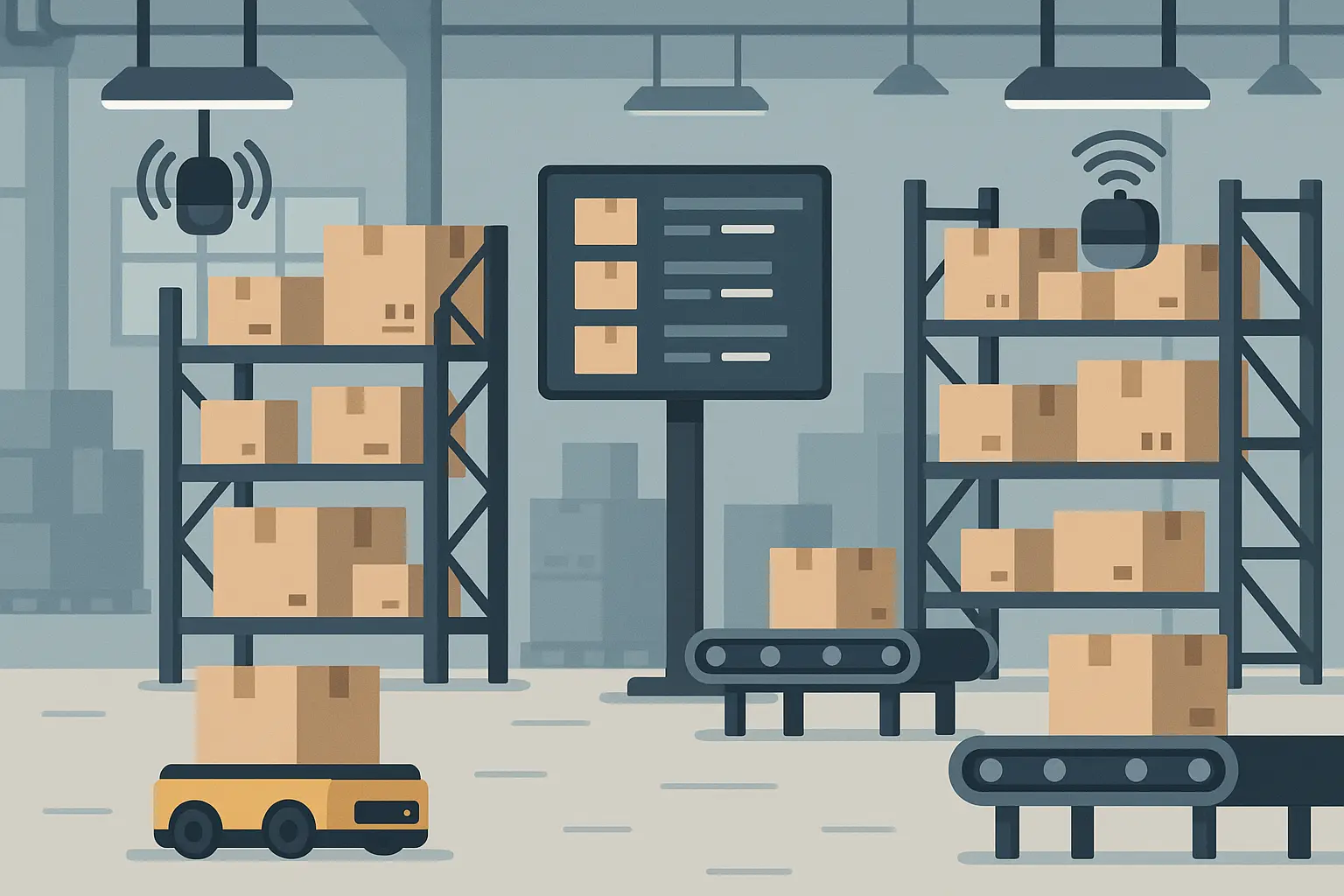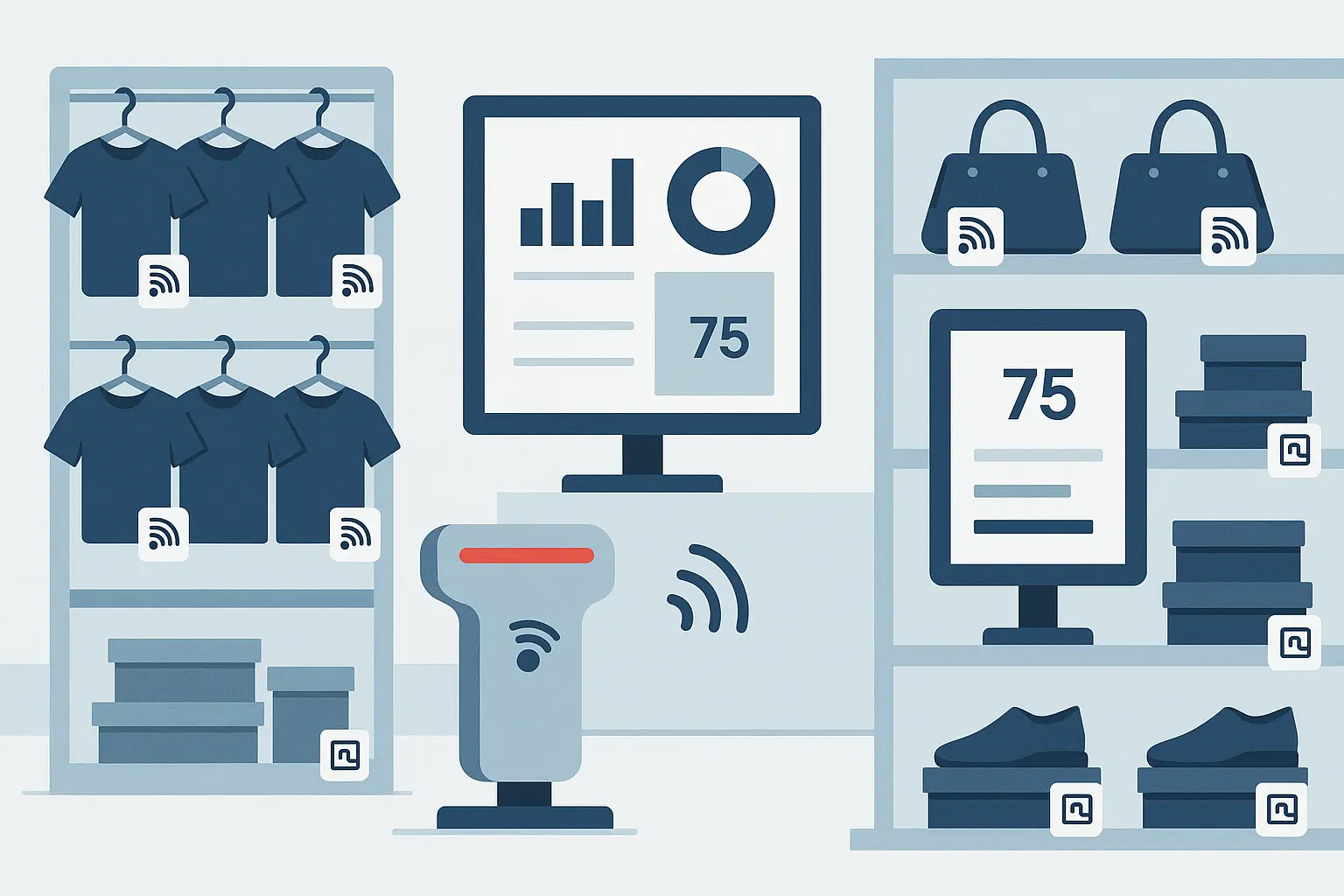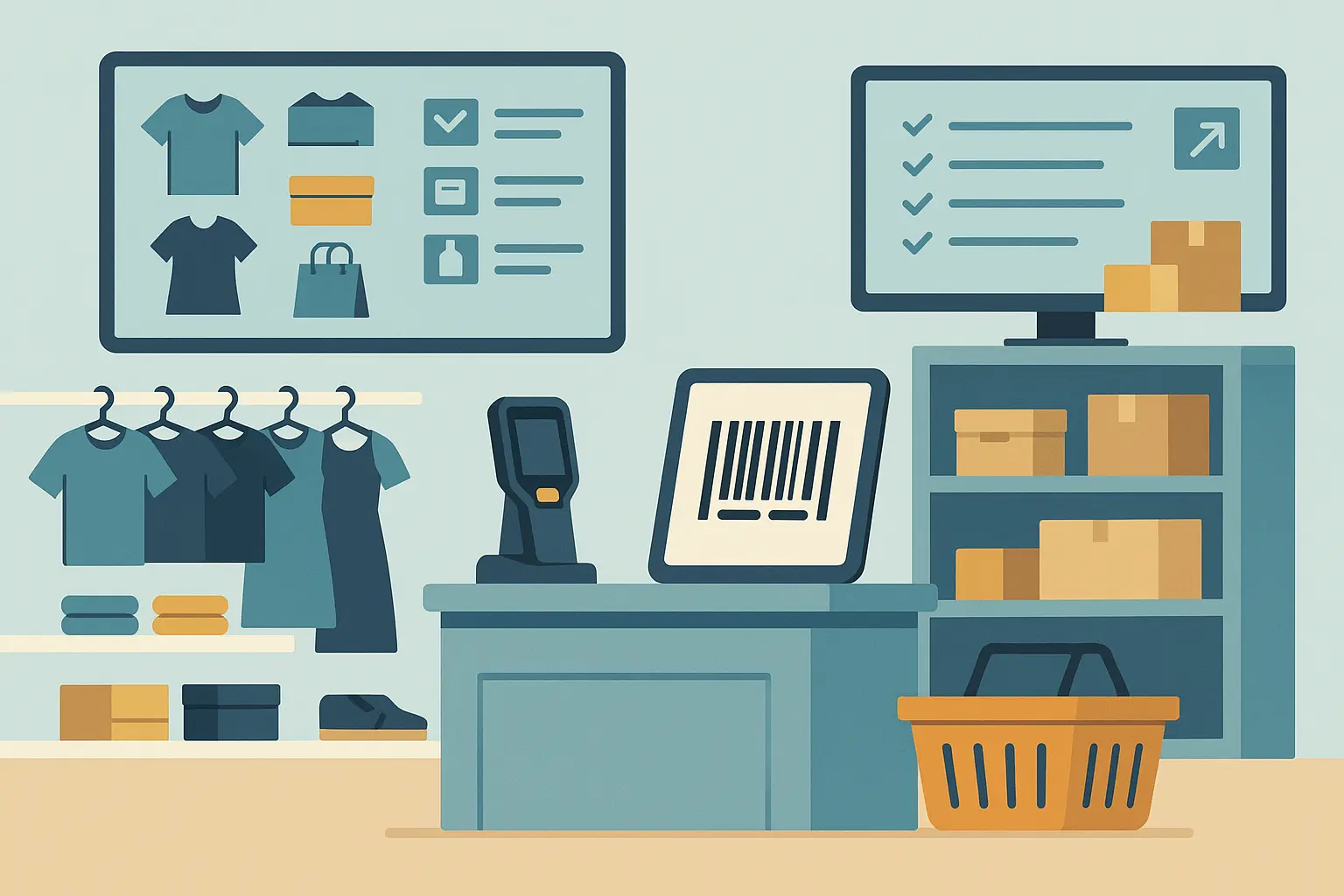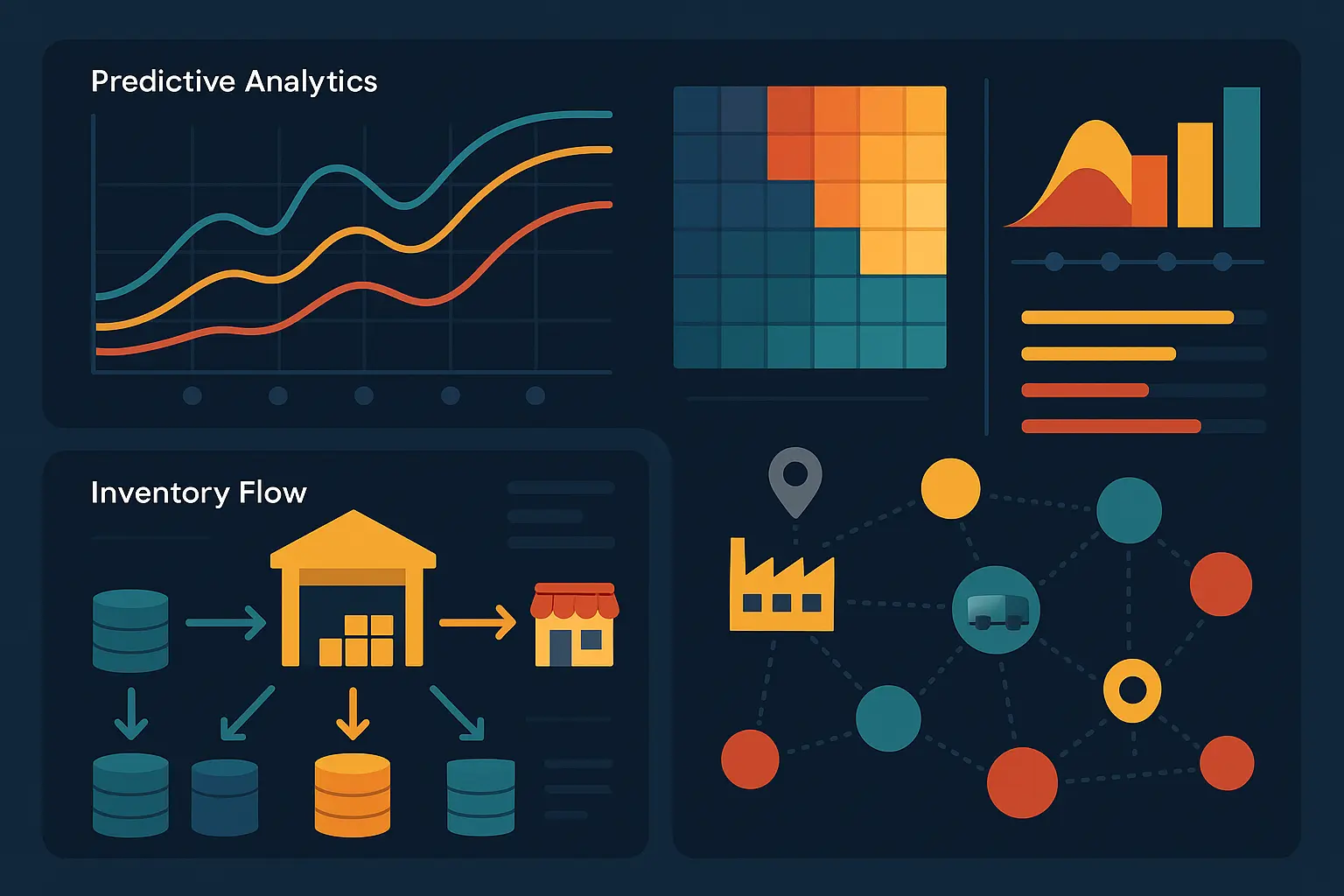Last month, I was talking to a business owner who told me something that stuck with me: “I feel like I’m playing inventory roulette every day.” Either he’s drowning in products nobody wants, or customers are asking for stuff he doesn’t have. Sound familiar?
Here’s the crazy part: companies using smart inventory systems are crushing their competition. We’re talking about improving logistics costs by 15%, cutting inventory levels by 35%, and boosting service levels by 65% compared to businesses still winging it. McKinsey & Co
I’ll be honest—I used to think inventory management was just about counting stuff until I dove deep into how the best companies actually do this. What I found blew my mind. These aren’t just businesses that got lucky—they completely reimagined how products flow through their operations.
I spent way too many late nights going down rabbit holes researching this stuff (my coffee addiction thanks me), but here’s what actually matters: 25 real-world examples that prove inventory management isn’t just operational housekeeping—it’s your secret weapon for dominating your market.

Table of Contents
-
What Makes an Inventory Management Case Study Worth Your Time?
-
Technology-Driven Success Stories (6 Case Studies)
-
Supply Chain Integration Wins (5 Case Studies)
-
Lean Manufacturing Breakthroughs (5 Case Studies)
-
Retail & E-commerce Innovations (5 Case Studies)
-
Healthcare & Pharmaceutical Solutions (2 Case Studies)
-
Food & Beverage Optimizations (2 Case Studies)
-
Deep Dive Analysis: The Most Complex Implementations
-
How to Evaluate These Case Studies for Your Business
-
Connecting Inventory Excellence to Marketing Success
-
Final Thoughts
TL;DR
-
Smart tech solutions like RFID and AI are delivering 15-40% improvements (but they’re not magic bullets)
-
Working closely with your suppliers can cut forecast errors by 30% and inventory levels by 25%
-
Lean manufacturing principles can slash carrying costs by 60% while making everything run smoother
-
Connecting online and offline inventory right can boost inventory turns by 20% and keep customers 35% happier
-
Healthcare and food businesses need specialized approaches because, well, people’s lives and health are on the line
-
Some solutions are weekend projects, others require complete overhauls—know the difference before you start
-
The winners combine technology with better processes instead of thinking software alone will save them
What Makes an Inventory Management Case Study Worth Your Time?
Here’s where I see most businesses mess up (myself included): they try to copy solutions that were never going to work in their situation. The difference between “this changed everything” and “we wasted six months and our budget” comes down to asking the right questions upfront.
Does This Actually Apply to Your World?
Your industry matters way more than you might think. A solution that works brilliantly for fast fashion might be completely wrong if you’re manufacturing heavy equipment. Company size is equally critical—what Amazon can pull off with unlimited resources won’t necessarily work if you’re running a mid-sized operation.
Understanding your business fundamentals is crucial before implementing any case study insights, which is why our retail math secrets guide provides the foundational calculations needed to evaluate inventory optimization opportunities effectively.
Market conditions matter too. A case study from 2019’s stable economy might not translate to today’s “everything’s on fire” supply chain environment.
|
How Well Does This Match Your Reality? |
Dead-On Match |
Pretty Close |
Not Really |
|---|---|---|---|
|
Industry Match |
Same type of business |
Related industry |
Completely different |
|
Company Size |
Similar revenue/scale |
Within 2x your size |
5x+ bigger or smaller |
|
Market Conditions |
Similar economic chaos/stability |
Comparable volatility |
Different universe |
|
Tech Setup |
Similar IT capabilities |
You could probably catch up |
Might as well be rocket science |
|
When This Happened |
Recent (2020+) |
2015-2020 |
Ancient history (pre-2015) |
What Problem Were They Actually Solving?
The best case studies don’t just brag about results—they clearly explain what was broken and why the obvious fixes didn’t work. This is where you separate the real insights from the corporate fluff.
Watch out for case studies that focus on symptoms instead of root causes. If a company says they reduced stockouts by 20% but doesn’t explain why they had stockout problems in the first place, you’re missing the important stuff.
Think about a mid-sized electronics retailer struggling with seasonal inventory. Instead of immediately trying to copy Amazon’s crystal ball approach (which needs massive data infrastructure), they might start with something like Home Depot’s localization strategy—actually understanding what different regions want and stocking accordingly. This tackles the real problem (not understanding demand) with something they can actually pull off.
How Did They Actually Make It Work?
Technology gets all the attention, but process changes and getting people on board are often way more important. How did they handle employees who didn’t want to change their workflows? What training did people need? These details matter when you’re planning your own implementation.
Show Me the Real Numbers
Vague improvements like “significantly better” don’t help anyone. Look for specific numbers: actual cost reduction percentages, how much inventory turnover improved, realistic timelines. And here’s the key—did the improvements stick around, or did they fade once the initial excitement wore off?
Technology-Driven Success Stories
Technology isn’t magic, but when you use it right, the results can seem pretty magical. These companies didn’t just buy fancy software—they completely rethought how inventory moves through their operations.

1. Walmart’s RFID Revolution
Walmart’s RFID rollout proves that sometimes the biggest wins come from solving basic problems really, really well. They stuck RFID tags on high-value items and clothes, connected everything to their existing systems, and suddenly could track inventory in real-time.
The numbers speak for themselves: 16% fewer stockouts, 10% better inventory accuracy, and $1.2 billion in annual savings. But here’s what most people miss—they cut manual counting by 75%, which freed up employees to do more valuable stuff than wandering around with clipboards.
2. Zara’s Fast Fashion Inventory Magic
Zara figured out fashion’s biggest challenge: predicting what people will want to wear before they even know it themselves. Their computer systems analyze everything from runway trends to what people are posting on Instagram, feeding into a supply chain that can go from design to store shelves in just two weeks.
Their 85% inventory turnover rate and 50% reduction in markdown costs prove that being fast beats being perfect in fashion. Instead of betting big on seasonal collections, they constantly refresh their offerings with micro-seasons.
3. Amazon’s Mind-Reading Inventory System
Amazon’s predictive system is basically the holy grail of inventory management—knowing what customers want before they order it. They analyze your browsing history, what you’ve bought before, your wish lists, and demographic data to pre-position inventory in warehouses near you.
Amazon’s success with predictive analytics mirrors the data-driven approaches we explore in our Amazon case study, which details how the company leverages customer data across all business functions to maintain competitive advantage.
The 25% faster delivery times and 98.5% order accuracy are impressive, but the real genius is how they handle the inevitable mistakes. They’ve optimized their return process so well that wrong guesses actually become a competitive advantage.
4. Tesla’s No-Safety-Net Manufacturing
Tesla eliminated traditional “just in case” inventory through crazy-precise supplier coordination and real-time production scheduling. Their systems connect directly with suppliers, and they adjust everything based on actual customer orders instead of guesses.
The 40% reduction in inventory costs and 95% on-time delivery show what’s possible when you stop playing it safe with buffer stock. But fair warning—this approach requires your suppliers to be basically perfect. One hiccup and everything stops.
5. Adidas’ Cloud-Based Inventory Brain
Adidas moved to a cloud system with AI that processes data from all their sales channels simultaneously. They can see inventory everywhere and fulfill orders from any location, while automated systems adjust stock levels in real-time.
The 20% better forecast accuracy and 35% less excess inventory prove that cloud-based solutions can deliver results fast. The 18% improvement in product availability directly translates to sales they would have lost to stockouts.
6. Best Buy’s Smart Inventory Platform
Best Buy built a system that combines traditional sales data with customer sentiment analysis and seasonal trend predictions. They get a complete picture of demand across all their channels instead of flying blind.
The 22% reduction in inventory investment while improving customer satisfaction by 28% shows that smart beats intuitive every time. Instead of guessing at safety stock levels, they calculate them based on actual risk factors.
|
Technology Solution |
How Hard Is This? |
What Will This Cost You? |
When Will You See Results? |
Main Benefit |
|---|---|---|---|---|
|
RFID Systems |
Moderately complex |
$50K-$500K |
12-18 months |
See everything in real-time |
|
AI Demand Forecasting |
Pretty complex |
$100K-$1M+ |
18-24 months |
Actually predict what sells |
|
Cloud Inventory Platforms |
Moderately complex |
$25K-$250K |
6-12 months |
Scale without breaking |
|
IoT Sensors |
Complex |
$75K-$750K |
15-20 months |
Automate the monitoring |
|
Predictive Analytics |
Very complex |
$200K-$2M+ |
24-36 months |
Know what happens next |
Supply Chain Integration Wins
Supply chain integration isn’t really about technology—it’s about trust, transparency, and making sure everyone wins when things go well. The companies that master this create advantages that are incredibly hard to copy.

7. Procter & Gamble’s “Let’s Actually Work Together” Approach
P&G’s collaborative planning with major retailers transformed how consumer goods companies work with stores. Instead of everyone guessing, they share forecasting platforms and actually plan together.
The 30% reduction in forecast errors and 40% better service levels came from eliminating the guesswork. When retailers share real demand signals instead of just orders, manufacturers can optimize their entire supply chain around what people actually buy.
8. Toyota’s Supplier Network Magic
Toyota extended their famous lean principles to supplier inventory management through digital integration. Their supplier portal enables real-time communication, while digital systems ensure parts arrive exactly when needed.
Toyota’s supplier integration approach exemplifies the operational excellence principles detailed in our Toyota case study, which explores how the company’s lean manufacturing philosophy extends throughout their entire value chain.
The 50% reduction in supplier inventory and 35% better delivery reliability prove that lean principles work beyond individual factories. Instead of suppliers guessing what Toyota needs, they share actual production schedules and customer orders.
Here’s a simpler version that worked: A furniture manufacturer created a shared digital dashboard with their top 5 suppliers. Instead of placing orders based on forecasts, they shared real-time production schedules and customer order data. This let suppliers adjust their production and delivery schedules proactively, cutting the manufacturer’s raw material inventory by 30% while improving on-time delivery to 95%.
9. Unilever’s “Good for Planet, Good for Profit” Supply Chain
Unilever integrated sustainability metrics into inventory decisions across their global operations. Carbon footprint tracking influences sourcing decisions, while circular economy models prioritize reusable and recyclable materials.
The 25% reduction in supply chain carbon footprint came with an 18% decrease in waste and 12% improvement in cost efficiency. Turns out sustainable practices aren’t just good for the planet—they’re good for your bottom line when you do them right.
10. Nestlé’s Global Inventory Chess Game
Nestlé implemented a global inventory system across 190 countries, creating centralized demand planning with regional inventory sharing. Excess stock in one region can fulfill demand in another.
Nestlé’s global optimization strategy demonstrates the scalability principles we examine in our Nestle case study, showing how multinational corporations can leverage their geographic diversity to create operational efficiencies.
The $500 million reduction in working capital and 30% better service levels show the power of global coordination. They’re not just optimizing individual locations—they’re optimizing the entire network.
11. IKEA’s “Nothing Goes to Waste” Inventory Model
IKEA developed a circular inventory system with
IKEA developed a circular inventory system with buy-back and refurbishment programs. Returned furniture gets refurbished and resold, while smart pricing algorithms optimize value recovery.
The 15% reduction in raw material costs and 20% improvement in customer loyalty prove that circular models create value for everyone. Customers get better prices on quality furniture, while IKEA reduces waste and material costs.
Lean Manufacturing Breakthroughs
Lean manufacturing isn’t just about eliminating waste—it’s about creating flow. When inventory moves smoothly through your operations, everything else gets easier.

12. General Electric’s War on Inventory Waste
GE applied lean principles to slash inventory waste while keeping production running smoothly. They mapped out where things got stuck and implemented pull-based systems that eliminated overproduction.
The 60% reduction in work-in-process inventory and 40% better production flow came from eliminating the “just in case” mentality. Their continuous improvement culture means these gains keep compounding as employees spot additional optimization opportunities.
13. 3M’s Statistical Approach to Inventory
3M used Six Sigma methodology to optimize inventory levels across their crazy-diverse product lines. Statistical process control and data-driven decision making replaced gut feelings throughout the organization.
The 35% reduction in inventory variability and 28% better forecast accuracy prove that statistical approaches work even for complex product portfolios. Cross-functional teams ensured solutions worked across different business units.
14. Boeing’s Lean Aerospace Inventory
Boeing implemented lean principles in aerospace inventory management—and if you can make lean work for airplane manufacturing, you can make it work anywhere. Supplier development programs and just-in-time delivery eliminated buffer stock without compromising quality.
The 45% reduction in inventory carrying costs and 50% improvement in supplier performance show what’s possible even in the most complex manufacturing environments. Quality-integrated processes ensure lean doesn’t compromise safety or reliability.
15. Ford’s Global Inventory Standards
Ford standardized inventory management processes across all their global manufacturing facilities. Common technology platforms and best practice sharing created consistency while allowing for local adaptation.
The 25% reduction in inventory levels and 35% better process efficiency came from eliminating redundant systems and processes. Global supplier coordination means they can leverage their scale more effectively.
16. Caterpillar’s Crystal Ball for Heavy Equipment
Caterpillar uses predictive analytics to optimize spare parts inventory for heavy equipment. Machine learning algorithms analyze equipment data to predict failures before they happen, enabling predictive maintenance scheduling.
The 30% reduction in spare parts inventory while improving equipment uptime by 40% proves that predictive approaches work for complex, high-value assets. Parts are positioned where they’re needed when they’re needed.
Retail & E-commerce Innovations
Retail inventory management has evolved from simple stock counting to sophisticated demand orchestration. The winners blend online and offline inventory into a seamless customer experience.

17. Shopify’s David vs. Goliath Inventory System
Shopify built a distributed inventory system specifically for small and medium-sized retailers. Multi-location inventory tracking and automated stock optimization help smaller merchants compete with the big guys.
Shopify’s distributed approach aligns with the scalable business principles we explore in our Shopify SEO case study, demonstrating how the platform enables merchants to compete effectively through both operational excellence and digital marketing optimization.
The 50% reduction in stockouts for merchants and 30% faster order fulfillment prove that sophisticated inventory management isn’t just for Fortune 500 companies. Real-time inventory sync across channels means customers always see accurate availability.
18. Target’s “Shop However You Want” Strategy
Target integrated online and offline inventory for a seamless customer experience. Their stores double as warehouses, enabling buy online/pick up in store and ship-from-store capabilities that maximize how they use every piece of inventory.
The 20% increase in inventory turns and 35% improvement in customer satisfaction show the power of thinking beyond traditional channels. Real-time inventory visibility means customers can shop however they want while Target optimizes fulfillment costs.
19. Alibaba’s Robot Army Warehouse
Alibaba implemented AI-powered warehouse management across their massive e-commerce platform. Robotic warehouse automation and AI-driven demand forecasting handle millions of different products across multiple countries.
The 70% reduction in order processing time and 50% improvement in inventory accuracy demonstrate what full automation can do. Dynamic pricing integration means inventory levels influence pricing decisions in real-time—more stock means lower prices, less stock means higher prices.
20. Home Depot’s “Not All Markets Are the Same” Approach
Home Depot localized inventory based on regional demand patterns and seasonal variations. Geographic demand analysis and weather-based forecasting ensure the right products are in the right locations at the right times.
The 18% reduction in excess inventory and 25% improvement in product availability came from understanding that Phoenix and Minneapolis don’t need the same stuff at the same time. Local supplier integration reduces shipping costs while improving responsiveness.
21. Costco’s “Less Is More” Philosophy
Costco’s unique approach to high-volume, low-variety inventory management creates incredible efficiency. Limited product selection and massive purchasing power enable rapid inventory turnover.
The 12 inventory turns per year and 85% inventory accuracy prove that sometimes less really is more. Supplier partnership programs create win-win relationships that benefit both Costco and their suppliers.
Healthcare & Pharmaceutical Solutions
Healthcare inventory management is literally life and death. The stakes are higher, the regulations are stricter, and the margin for error is essentially zero.

22. Johnson & Johnson’s Cold Chain Perfection
J&J implemented temperature-controlled inventory management for pharmaceutical products using IoT sensors and blockchain technology. Automated quality control systems and regulatory compliance integration ensure product integrity throughout the supply chain.
The 99.8% temperature compliance rate and 40% reduction in product waste prove that technology can solve even the most demanding inventory challenges. Blockchain transparency provides the audit trail required for regulatory compliance—because when the FDA comes knocking, you better have your paperwork straight.
23. Mayo Clinic’s Medical Supply Optimization
Mayo Clinic optimized medical supply inventory across multiple hospital locations through centralized procurement and usage-based replenishment. Emergency stock management ensures critical supplies are always available when needed.
The 25% reduction in inventory costs and 50% improvement in stock availability show that healthcare can benefit from retail-style inventory optimization. Cost-per-procedure optimization helps control healthcare costs without compromising patient care.
Food & Beverage Optimizations
Food and beverage inventory management requires balancing freshness, waste, and profitability. Get it wrong and you’re either throwing away expired products or disappointing customers with empty shelves.

24. Coca-Cola’s Global Harmony
Coca-Cola synchronized inventory management across global bottling partners using standardized processes and demand sensing technology. Promotional inventory planning and local market adaptation ensure global consistency with local relevance.
Coca-Cola’s global synchronization strategy exemplifies the brand consistency principles we analyze in our Coca-Cola case study, demonstrating how global brands can maintain unified operations while adapting to local market conditions.
The 20% reduction in inventory levels and 30% improvement in service levels came from eliminating silos between bottling partners. Local market adaptation means global brands can respond to regional preferences and seasonal variations.
25. Whole Foods’ Smart Perishable Management
Whole Foods optimized perishable product inventory to minimize waste while maintaining freshness through predictive spoilage models and freshness-based pricing algorithms. Dynamic markdown strategies maximize value recovery from products approaching expiration.
The 35% reduction in food waste and 20% improvement in gross margins prove that smart pricing can turn potential waste into profit. Local sourcing prioritization reduces transportation time and supports community suppliers.
Deep Dive Analysis: The Most Complex Implementations
Some inventory management innovations are so complex they deserve deeper analysis. These aren’t solutions you can implement next quarter—they’re multi-year transformations that require fundamental changes to how you think about inventory.

Amazon’s Mind-Reading System: The Ultimate Prediction Game
Amazon’s anticipatory shipping is like having a crystal ball, but instead of magic, it’s just really, really good at analyzing your digital footprints. The system processes millions of customer interactions daily, analyzing browsing history, purchase patterns, wish lists, and demographic data.
The technical setup runs on cloud-based processing with real-time data streams and distributed computing. Inventory gets pre-positioned in regional fulfillment centers based on predictive models, with dynamic allocation adjusting based on what’s actually selling right now.
Here’s the crazy part about risk management: they’ve got sophisticated algorithms to minimize shipping stuff to wrong locations, plus optimized return logistics to handle the inevitable mistakes. They’ve actually built financial models that account for increased return rates and customer communication strategies to manage delivery surprises.
Tesla’s No-Safety-Net Manufacturing: Playing Without a Net
Tesla’s approach eliminates traditional inventory buffers through insanely precise supplier coordination and real-time production scheduling. Direct connections with suppliers enable real-time communication, while dynamic scheduling bases production on actual customer orders rather than forecasts.
The technical components include real-time production monitoring with IoT sensors, automated supplier notification systems, and predictive maintenance to prevent production disruptions. Advanced planning software coordinates everything in real-time.
But here’s what nobody tells you about Tesla’s approach—it only works if your suppliers are basically perfect. Challenges include supplier reliability (solved through multi-sourcing strategies), demand volatility (handled with flexible production capacity), and quality risks (managed through intensive supplier auditing and real-time quality monitoring).
How to Evaluate These Case Studies for Your Business
The key to getting value from these case studies is being brutally honest about what applies to your situation. I’ve seen too many companies try to copy Amazon’s approach when they should have started with something like 3M’s Six Sigma methodology.
Does This Actually Match Your Reality?
High-relevance examples include Walmart’s RFID (works across retail industries with lots of different products), Toyota’s supplier integration (relevant for any manufacturing with complex supplier networks), and Target’s omnichannel approach (applicable to any retailer with both physical and digital presence).
Medium-relevance examples like Tesla’s just-in-sequence manufacturing are limited to industries with predictable production schedules, while Amazon’s anticipatory shipping requires massive customer data and sophisticated analytics capabilities.
A regional sporting goods chain evaluated these case studies and identified Target’s omnichannel approach as most relevant. They started by implementing inventory visibility across their 15 stores, enabling customers to check stock online and reserve items for pickup. This simple first step increased inventory turns by 12% and customer satisfaction scores by 18% within six months, proving that you don’t need Amazon’s complexity to see meaningful results.
Can You Actually Pull This Off?
High feasibility solutions are ones you can probably tackle without selling a kidney or hiring a team of consultants. 3M’s Six Sigma approach needs training and process changes but minimal technology investment. Home Depot’s localization uses existing data with enhanced analytics capabilities.
Medium feasibility solutions like Target’s omnichannel strategy require system integration and process redesign. Best Buy’s intelligence platform needs data integration and analytics capabilities.
Low feasibility solutions require massive investment. Amazon’s anticipatory shipping needs huge data infrastructure and machine learning capabilities. Tesla’s just-in-sequence requires complete supplier network transformation.
|
Case Study |
How Relevant Is This? |
How Hard Is This Really? |
What Will This Cost? |
Realistic Timeline |
|---|---|---|---|---|
|
Walmart RFID |
Very relevant |
Moderately tough |
$100K-$500K |
12-18 months |
|
Toyota Supplier Integration |
Very relevant |
Pretty tough |
$200K-$1M |
18-24 months |
|
3M Six Sigma |
Very relevant |
Not too bad |
$25K-$100K |
6-12 months |
|
Target Omnichannel |
Somewhat relevant |
Moderately tough |
$150K-$750K |
12-18 months |
|
Amazon Anticipatory |
Probably not relevant |
Extremely tough |
$1M+ |
24-36 months |
|
Tesla Just-in-Sequence |
Probably not relevant |
Extremely tough |
$500K-$2M |
18-30 months |
How Good Is the Data Behind This?
Highly validated case studies like Toyota, Walmart, and P&G have multiple third-party validations, academic studies, and industry recognition. The methodology is transparent with clear disclosure and peer review.
Moderately validated examples like Amazon, Tesla, and Zara provide company-reported results with some third-party analysis, but limited methodology disclosure due to competitive advantage concerns.
Connecting Inventory Excellence to Marketing Success
Here’s something most people completely miss: inventory management and marketing success are deeply connected. You can run the most brilliant marketing campaign in the world, but if your inventory can’t support it, you’re basically lighting money on fire while annoying potential customers.
The Data Connection That Changes Everything
The most successful inventory management case studies share a common thread with effective marketing: they don’t gamble on assumptions but instead rely on data-driven strategies. Amazon’s predictive analytics and Walmart’s RFID implementation both use the same analytical mindset that drives successful marketing campaigns.
The analytical foundation required for inventory optimization mirrors the data-driven approach we detail in our marketing ROI calculator, which helps businesses quantify the financial impact of both operational improvements and marketing investments.
Ever run a Facebook ad for a product you didn’t have in stock? Yeah, that’s basically lighting money on fire while annoying potential customers. Smart inventory systems prevent those facepalm moments. Marketing implications of inventory excellence include customer experience optimization (proper inventory levels directly impact satisfaction and reviews), campaign performance (marketing campaigns fail when promoted products are out of stock), and market responsiveness (agile inventory systems can capitalize on marketing-driven demand spikes).
ROI-Focused Inventory Strategies
Consider how Zara’s inventory model enables rapid response to marketing-identified trends, or how Target’s omnichannel approach supports integrated marketing campaigns across all customer touchpoints. The quantifiable marketing benefits include reduced advertising waste, enhanced customer lifetime value, and improved conversion rates.
Strategic Integration Opportunities
For businesses investing in marketing services—whether PPC, email marketing, or inbound marketing—inventory management excellence becomes a force multiplier for marketing ROI. Real-time inventory data prevents advertising out-of-stock products, while inventory insights enable personalized product recommendations and timely restock notifications.
The most successful companies understand that inventory management isn’t just an operational function—it’s a strategic enabler of marketing success. When you combine scientific marketing approaches with proven inventory management principles, you create a competitive advantage that compounds across both operational efficiency and marketing effectiveness.
This is where The Marketing Agency’s expertise becomes invaluable. We understand how inventory challenges can undermine even the best marketing strategies. Our data-driven approach to PPC campaigns, email marketing, and inbound marketing integrates seamlessly with optimized inventory management to ensure your marketing investments generate maximum returns while your operational excellence amplifies marketing performance.
Final Thoughts
Look, I could sit here and tell you that implementing these systems is easy, but that would be lying. Some of this stuff is genuinely hard. The companies featured in these case studies didn’t achieve success by accident—they invested in understanding their inventory challenges, implemented solutions systematically, and measured results obsessively.
Most importantly, they viewed inventory management as a strategic capability rather than just operational housekeeping. Whether you’re drawn to Amazon’s predictive sophistication or 3M’s methodical Six Sigma approach, the key is starting with a clear understanding of your current mess and where you want to end up.
Before you get too excited about copying Amazon’s approach, remember—they have a few more resources than your average business. Start with what you can actually handle. The best inventory management solution for your business is the one you can implement successfully and sustain over time.
But here’s the thing everyone overlooks: the companies that figure this out aren’t just surviving—they’re leaving their competition wondering what happened. The intersection of inventory excellence and marketing success creates opportunities that most businesses never realize. When your inventory supports your marketing efforts instead of constraining them, you unlock growth potential that compounds across every customer interaction.
Start small, measure everything, and don’t try to be Amazon on day one.




